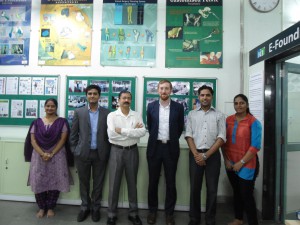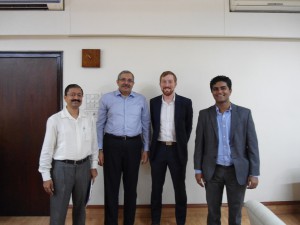26th September 2014 Mumbai, India
IIT Bombay
Last month, Tom and I visited the Indian Institute of Technology (IIT) Bombay. First, we met with Prof. B. Ravi in the Department of Mechanical Engineering. Prof. Ravi was part of the Indian delegation I led to the UK in June this year to participate in a 4-day programme on distributed manufacturing, which was jointly organised by the Royal Academy of Engineering and Indian National Academy of Engineering. Prof. Ravi’s laboratory focuses on two primary research areas – metal casting and medical implants, and has several ongoing collaborations.
 Prime Minister Narendra Modi’s recent clarion call – Come, Make in India! – was applauded by national and international stakeholders. Interestingly, this chimes well with Prof. Ravi profound publication (written nearly a decade ago) titled, “Made in my India – the past, present and future of Indian manufacturing industry”. The publication is a fascinating read; it is split into four sections – manufacturing for wealth creation, history and geography of manufacturing, future drivers and enablers, and manufacturing policy framework.
Prime Minister Narendra Modi’s recent clarion call – Come, Make in India! – was applauded by national and international stakeholders. Interestingly, this chimes well with Prof. Ravi profound publication (written nearly a decade ago) titled, “Made in my India – the past, present and future of Indian manufacturing industry”. The publication is a fascinating read; it is split into four sections – manufacturing for wealth creation, history and geography of manufacturing, future drivers and enablers, and manufacturing policy framework.
Prof. Ravi introduced us to E-Foundry – an online learning resource for casting design and simulation. Besides the simulation lab, the portal also hosts The Hub, which is an online forum for casting and simulation enthusiasts to either post questions or start a discussion thread! Watch video tutorials here.
We then met with Prof. Devang V. Khakhar, Director of IIT Bombay since 2009; his second term began in 2014. We discussed several topics with him including research collaborations between the UK and IIT Bombay. Prof. Khakhar mentioned that water, as an area of research, was of tremendous interest to the institution. This is particularly relevant for India given its burgeoning urbanisation. It is both noteworthy and timely that energy-water-food nexus has been identified as one of the research challenges under the Newton-Bhabha funding initiative with India.
 Prof. Khakhar emphasised the need for increased mobility of researchers between countries to foster international partnerships. To that end, he suggested that UK researchers could spend time at the IIT Bombay as guest appointees to pursue both research and teaching. This could serve as a first step towards establishing long-term research collaborations. We expect, under the ‘people’ strand of the Newton-Bhabha funding initiative, resources will be made available for the exchange of researchers between the UK and India. The Royal Society of Chemistry already offers Research Mobility Fellowships to PhD and Masters’ degree students as well as early career researchers to support short-term scientific visits to the UK.
Prof. Khakhar emphasised the need for increased mobility of researchers between countries to foster international partnerships. To that end, he suggested that UK researchers could spend time at the IIT Bombay as guest appointees to pursue both research and teaching. This could serve as a first step towards establishing long-term research collaborations. We expect, under the ‘people’ strand of the Newton-Bhabha funding initiative, resources will be made available for the exchange of researchers between the UK and India. The Royal Society of Chemistry already offers Research Mobility Fellowships to PhD and Masters’ degree students as well as early career researchers to support short-term scientific visits to the UK.
Finally, Prof. Khakhar recommended that we meet with Prof. Krishna K. Kaliappan, Associate Dean for Research & Development, to learn more about the ongoing projects at the institution. During our conversation with Prof. Kaliappan, we found out about the Industrial Design Centre – a centre of excellence for design research. The centre offers post graduate programmes in industrial design, visual communication, animation, interaction design, and mobility and vehicle design.
As we wrapped up our meetings and visits, and were exiting the IIT Bombay campus, we had already planned our next visit to this excellent institution later this year. Watch this space for updates. If you’re a UK based researcher and would like to know more about IIT Bombay or connect with one of its researchers, please drop me a line and I’d be happy to make an introduction!